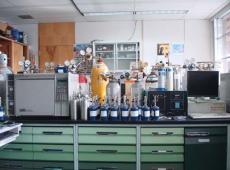Smoke samples collected during experiments in the Fire Lab combustion chamber, from the FASS towers at wild or prescribed fires, or from aircraft traversing a smoke plume, are analyzed in the Gas Chromatography Lab. Fire emissions (smoke) contain a complex mixture of gases.
The major emission products of biomass burning are carbon compounds- carbon dioxide (CO2), carbon monoxide (CO), methane (CH4), other hydrocarbons (such as propane), and aerosols. Quantifying these emissions is critical to assessing the impact of wild and prescribed fires on air quality, regional and global atmospheric chemistry, and the role of fire in the carbon cycle.
Function and Objective:
The results of the laboratory analyses are reported in scientific journals for different types of fires and fuels. They are used to produce emission factors for major smoke chemical components. Emission factors are used to predict the quantity of emissions from different types and sizes of fires of different vegetation types and fuel loadings, and are reported in units of grams of a specific compound emitted per kilogram of fuel burned. Emission factors are inputs into models assessing the impacts of emissions on global atmospheric chemistry and more local air pollution from smoke.
Gas Chromatographs
Canister samples of smoke collected in field or laboratory experiments are analyzed for CO2, CO, methane, and other hydrocarbons. The canisters are stainless steel with electro-polished inner surfaces designed for air sampling. We have three gas chromatograph configured to measure the different gases in smoke.
Agilent 7890 - measures CO2, CO, and hydrocarbons in the canisters. It has two columns and dual flame ionization detectors (FIDs) to simultaneously measure CO2 and CO with a packed column, and methane and C2 to C6 hydrocarbons with a second capillary column.
Trace Analytical RGA3 - uses a reduction gas detector (RGD) for analysis of ppb trace level CO and hydrogen measurements. It allows us to measure with high accuracy ppb levels of CO in low concentration samples such as those collected from aircraft sampling experiments.
Agilent 6890/5973N - has a mass selective detector (GC/MS) and is integrated with an Entech 7100A sample pre-concentrator to detect low concentrations of a wide range of hydrocarbons, aromatics, oxygenated compounds and halocarbons.
Filter Room
To quantify the amount of particulates in smoke Teflon filters are collected by the FASS system and other sampling methods in the field and combustion chamber. The controlled environment filter room conditions the sample filters at specific temperature and humidity, due to the sensitivity of the particulate matter and filters to moisture, which causes them to vary in weight with changing room humidity. A Mettler MT-5 micro-balance weighs the filters to within 1 microgram to measure the mass of particulate deposited on the filter. The weights are used with filter flow data to calculate particulate concentrations. Teflon filter samples are weighed to calculate the fine particulate concentration (PM2.5) emitted during different phases of the fire (flaming, intermediate, smoldering).
Lab and Field Measurements Instrumentation
Picarro 2401-m measures CO2, CO, CH4 and water vapor at parts-per-billion (ppb) sensitivity. with negligible drift for continuous high quality data collection. Its Cavity Ring-Down Spectroscopy (CRDS) technology is capable of very fast response measurements to track gas concentrations for combustion chamber fire emission experiments and sampling through smoke plumes when deployed in aircraft.
Thermo Scientific Model 42i NO-NO2 -NOx Analyzer measures major nitrogen emissions from biomass fires. It is also used in the combustion chamber and field experiments such as pile burn emissions. It utilizes chemiluminescence to measure the amount of nitrogen oxides in the air from sub-ppb levels up to 100ppm.
microAeth AE51 Aethelometer measures real time black carbon concentrations. Black carbon particles strongly absorb sunlight and give soot its black color. Black carbon can be produced as a result of the incomplete combustion of biomass such as in forest fires. BC remains in the atmosphere for only a few weeks. The aethelometer performs real-time analysis by measuring the rate of change in absorption of transmitted light (880 nm) from continuous collection of aerosol deposition on a filter. The aethelometer is used for both field and laboratory measurements.
LECO TruSpec CNS Analyzer – measures the carbon, nitrogen and sulfur content of vegetation and soil samples. The amount of carbon, nitrogen and sulfur in fuels is one determining factor in the concentration of these elements in emissions. Vegetation and soil samples are combusted in a pure oxygen environment and the resulting gases are measured to determine sample elemental concentrations.

